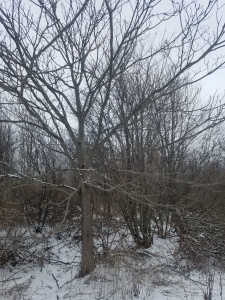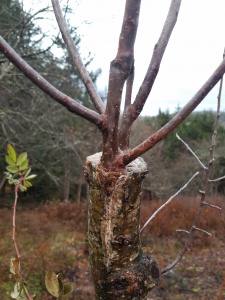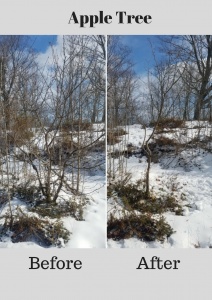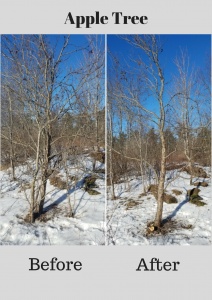When we proposed establishing an orchard on this land, we were guided by the understanding that the land was of marginal (immediate) value for hay production or tillage crops due to a recent history of neglect and likely disturbance during the construction of the adjacent Interstate 89 in the late 1960’s. Our belief in the suitability of an orchard came primarily through walking the land and observing that the hedgerows, crowded onto rocky outcroppings, were home to some three dozen young wild apple trees, some producing fruit.
We quickly found another 30-odd apple saplings and another 20-odd hawthorn saplings, which can be used as rootstock for grafting pear varieties. Without any human work or inputs, indeed through neglect, this land managed to grow nearly 100 trees on rocky outcroppings, which can now be managed and nurtured for better fruit production.
The land also has several Butternut trees, a couple of which are in good shape and producing nuts. In one spot there grows a butternut overstory producing nuts, with a taller and shorter shrub layer including native Serviceberry, and Elderberry. Again, this happened without any human intervention.

With all that growth happening on the areas that were unsuitable for even a brushhog, we predict that the soils of the open field will be even more productive.
Grafting
The vast majority of fruit and nut trees do not reproduce true-to-kind from seed. That is, if you have a wonderful apple growing on an old farm and you take that apple home, extract the seeds, and plant them, those seedlings will not bear the fruit that the parent tree did. The way that a certain variety is passed down and disseminated is through grafting, that is, joining a cutting (a scion) from the desired tree to a rootstock. While there are dozens of methods and variations on forming a graft union, it all hinges on aligning the cambium (the green, living part) of the two pieces. There was originally only one tree that someone liked and called “McIntosh” or “Wolf River” or “Hudson’s Golden Gem” and twig by twig, that variety was grafted and planted into hundreds or thousands of backyards and orchards.
In preparation for grafting season, we have been gathering scionwood from various sources. Some are heirloom varieties from abandoned orchards, some are from the hedgerows of surrounding farms, suggested by neighbors. Some are from the collections of other local enthusiasts.

Pruning
Besides grafting, much work has been undertaken to release wild apple trees (ones that will be grafted onto) from competition with more vigorous trees. Left to their own, apple trees tend to produce multiple stems which compete with each other and can decrease fruit production. While there was a lot of preliminary pruning to be done, most of the trees revealed a good usable structure.
Thank you for reading. Soon, we will post about the process of gathering scionwood. We are also working on a blog post about the history of this land and its recent conservation. Stay tuned!
Best wishes,
Camden Walters, Orchard Manager & Jess Taffet, Program Director



